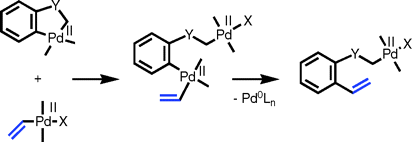A computational study has been performed to determine the mechanism of the key steps of Pd-catalyzed domino reactions in which C(sp2)-C(sp2) are formed from aryl and alkenyl halides. DFT calculations were done on model complexes of the proposed intermediates, with PH3 and H2O as ancillary ligands, to explore two possible mechanisms: the oxidative addition of aryl or alkenyl halides to palladacycles to give Pd(IV) intermediates, and the transmetalation-type reaction of aryl or alkenyl ligands between two Pd(II) centers, a palladacycle, and a Pd(II) complex formed by oxidative addition of aryl or alkenyl halides to Pd(0). We have shown that oxidative addition of iodoethylene to Pd(0) precursors is more favorable than oxidative addition to Pd(II) palladacycles, whereas transmetalation-type reactions between Pd(II) complexes are facile. Similar results were obtained with iodobenzene instead of iodoethylene and formamide as the ancillary ligand. These results suggest that Pd(IV) intermediates are not involved in these reactions.
